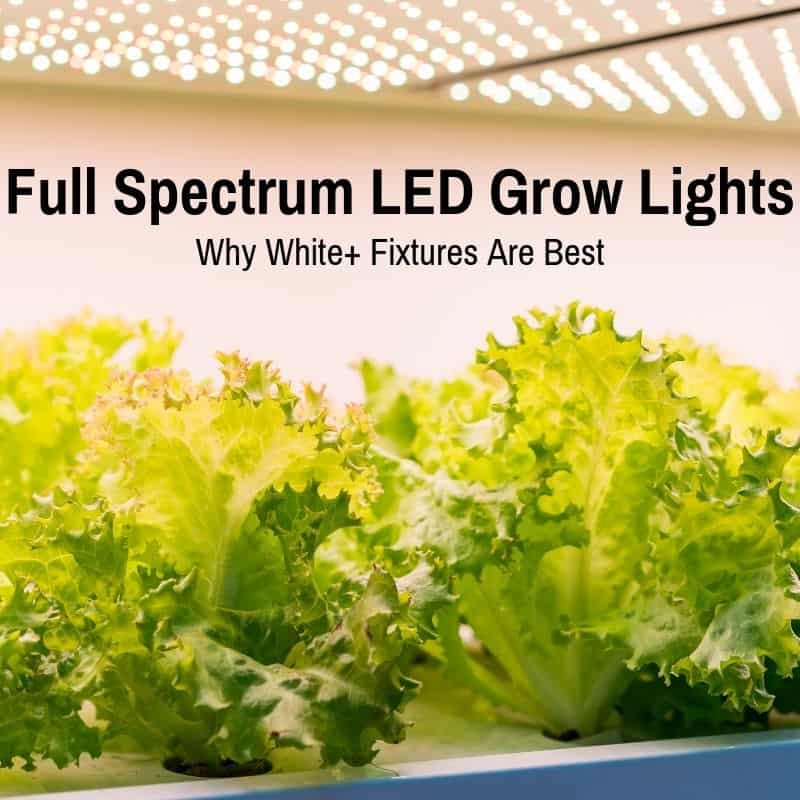 Aren’t they all full-spectrum LED grow lights?
Aren’t they all full-spectrum LED grow lights?
No. They are labeled as such, but they are not actually full-spectrum.
Most contain LED diodes in multiple colors.
That means they have specific wavelengths, but not every wavelength. The wavelengths between the diodes the light contains are missing.
There is only one way to get a true full-spectrum output.
That is with white light.
I will explain why and also which combination of diodes gives you the best light for plants (hint: only white is not as effective as white plus additional diodes).
I will also show why LEDs and CMH bulbs are the only two cost effective ways to get the ideal full-spectrum white light.
And I will show you exactly which LED fixtures provide this ideal light and do so at a reasonable cost. Why spend over a thousand dollars on a light, when you can get the same thing for a few hundred?
Contents
- 1 Best Full Spectrum LED Grow Lights
- 2 Full Spectrum Grow Lights: Why LED?
- 3 Full Spectrum LED Grow Light Reviews
- 4 Full Spectrum LED Grow Lights: Final Thoughts
Best Full Spectrum LED Grow Lights
Here’s a quick summary of the best plant grow lights. If you’re curious why I chose these lights, you’ll find brief reviews for each below and also links to more in-depth reviews.
Full Spectrum Grow Lights: Why LED?
HID lights are full-spectrum, as are fluorescent lights. So why should you go with LED?
You’ll find much more detail here, but basically, LED grow lights are the only form of horticultural lighting that give you the ideal mixture of different colors of light, (because they can have any color of light you want), that deliver that light efficiently, and that achieve enough output to flower plants.
Let’s look at each type of full-spectrum horticultural lighting.
Best Full Spectrum Grow Lights
HPS and MH both work well and have for a long time, but they do not give you the ideal mix of colors. HPS lacks blue light and MH lacks red light. Both work, but would work much better with a fuller spectrum.
Among HID bulbs, only CMH bulbs give you a full spectrum light. As such, they give you the ideal (or very close to ideal) mix of light, and they do it very efficiently.
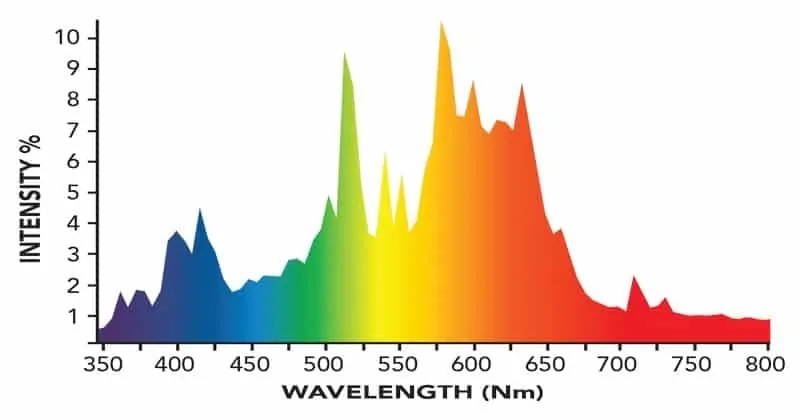
Ceramic metal halide bulbs are the only type of lighting I recommend besides LED. I prefer LED, because it is more efficient (more output while using less power) and runs cooler.
As for fluorescent lighting, it simply does not have the power to flower larger gardens effectively. For a small grow, they are great. You can just pick up some fluorescent bulbs at Home Depot or a similar store and start growing without spending much on lighting.
But for a large grow, you would need too many lights and once you get that many, fluorescent lighting is no longer efficient (higher power usage and more heat).
In short: LED grow lights can provide the perfect spectrum and give you a large output while consuming less power. The only other lighting system that comes close is ceramic metal halide.
The only problem with LED lighting: most of it is not great.
You have to know exactly which ones to get, or you’ll end up with one that is far from ideal.
What you don’t want is a light using red and blue diodes. Often referred to a purple, or blurple, LEDs, the manufacturers of these lights refer to them as “full spectrum”. But they are not.
Even if they have diodes in many other colors, they are not really full spectrum.
Each diode emits one specific wavelength, which means that there is no light in the wavelengths in between. For example, if a light has red diodes emitting the wavelengths 630 nm and 660 nm, it does not emit light with a wavelength of 640 nm or 650 nm.
Can you really call this full spectrum, if it only has light in very specific wavelengths?
No you can’t. And the only way to get a full spectrum LED grow light is to use white diodes, since white light is made up of light in every color.
Full Spectrum White LED Grow Light
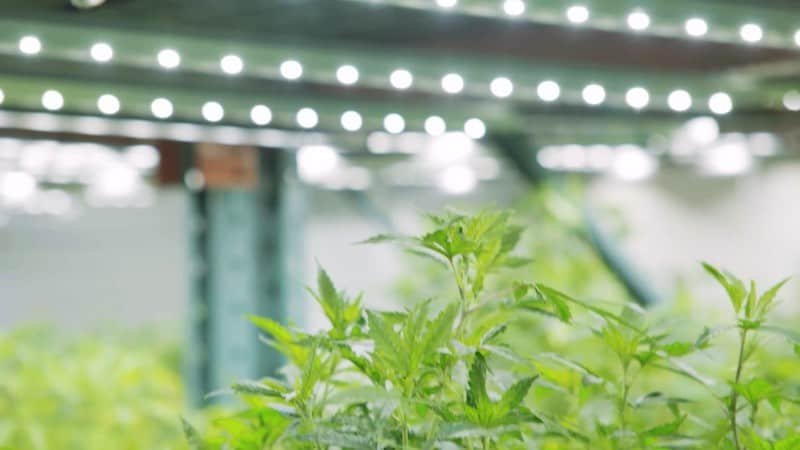
Full spectrum white LED fixtures can be made up entirely of white diodes, or they can have some white diodes, along with other colored diodes. Either way, the white light covers the full spectrum of visible light.
What is the best way to deliver full-spectrum white LED light?
COBs or quantum boards or bar style lights.
Chip-on-board LEDs are available in several different colors, but for horticultural applications, manufactures use two: warm white (3000K or 3500K) and cool white (4000K to 7000K).
Both deliver a full-spectrum white light that is great for all stages of plant growth. The warmer ones are better for flowering, while the cooler ones are better for vegging. Many fixtures will include a mix of both.
Quantum boards deliver the same color spectrum, but do so using many small diodes spread out over a large area, instead of using a few extremely powerful diodes. Bar style lights do the same, except the diodes are arranged in separate bars, instead of a larger panel.
Why are COBs, bar lights, and quantum boards better than “blurple” lights?
COBs have far more power than regular LED diodes, meaning they penetrate much deeper beneath the canopy. This huge advantage leads to bigger and better yields.
Quantum boards and bars have a much more even coverage, due to their large size. This means plants throughout the grow area get large amounts of light, which also leads to bigger and better yields.
More importantly, all-white light contains light at every wavelength, making it a true full-spectrum light. “Blurple” LEDs usually only emit light at certain wavelengths, unless they also include white diodes (as the BestVA light does).
As good as the all-white spectrum is, there is an even better mix of colors. That is the all-white spectrum mixed with additional red and blue diodes, as well as UV and IR.
Let’s take a look at the best plant lights on the market that mix white quantum boards or COBs with additional diodes, the best COB only grow light, and the best grow lights using regular diodes only (with a mix of all-white and colored).
Full Spectrum LED Grow Light Reviews
Below are the best full spectrum LED plant lights on the market today. My top recommendations combine COBs, or Samsung quantum boards or bars, with supplemental diodes.
I’ve also included a line of plant lights that achieves a great spectrum using a mix of colored diodes, for those who prefer regular “blurple” LEDs. Finally, I have a second, but lower priced option for both COBs and quantum boards, for those on a budget.
Best Bar Lights: Spider Farmer SE Series
- Samsung LM301B diodes — extremely efficient, achieving 2.75 umol/J
- Full spectrum light — can be used during all stages of growth, with white light plus deep red, UV and IR for a bloom boost
- Large even coverage — large form factor and spread out bars makes for a more even light distribution
- Daisy chainable — connect up to 30 lights
- Runs on AC100-240V — SE lights will work at any standard voltage (except SE1000W, which needs 220v)
- Rated for 100,000 hours — 8-10 years with no light bulb changes
- Includes light, hanging kit and power cord — everything you need to start growing immediately
We talk about Spider Farmer a bit more below, so I won’t go into much about the brand here. The specs are also easy to see on the product pages and in the table above, so there is no need to go into detail on those either.
The main thing to discuss here is the reason we consider these the best bar lights and not any of the other brands that have also started making bar lights (it’s most of them at this point).
It is important to point out that there are better lights. The Fluance Spyder and Gavita bar lights are the two best. But both of those cost much more than the Spider Farmer lights.
We simply don’t feel the higher price gets you all that much more. Will your plants grow much faster or produce noticeably bigger and better buds under the more expensive lights? Not really.
You mainly get slightly better quality control and customer service, but Spider Farmer does both of those things pretty well, too. They certainly do them better than other Chinese brands.
That is also the reason we consider them better (much better) that some of the other “high-end” brands like Optic and Grower’s Choice.
The reason “high-end” is in quotes is that both of these brands manufacture their lights in China and have horrific customer service, that is actually worse than some Chinese brands, like Spider Farmer. Yet their lights cost more.
And then there are all the other Chinese brands that now make bar lights, too. It’s basically all of them: Mars Hydro, Viparspectra, etc. You name a brand and chances are, they have a line of bar lights.
Many of them are cheaper than Spider Farmer, but the better ones are never much cheaper. The ones that are much cheaper have much higher failure rates. And if your light fails, good luck getting it replaced.
Now to the lights themselves. You probably already know the advantages of bar lights, but we’ll mention the two primary ones here.
The first is a much more even coverage area and these lights certainly give you that. The second is good heat control. The lights still put off just as much heat, so you still need to cool your grow room. But the heat doesn’t affect the lights, since the bar design allows plenty of air flow to cool down the chips.
Pros
- Highest quality components (Samsung LM301B, etc.)
- Great spectrum for any stage with 3000K and 5000K white light, plus 660 nm red, 760 nm IR, and 400nm UV
- Highly efficient with 2.7.5 μmol/J
- Dimmable
- Can daisy chain up to 30 lights
- Incredibly even coverage
- 3 year warranty and 30 day money back guarantee
Cons
- Lack of fans means bars can get quite hot, but airflow around them is great
- More expensive than the Spider Farmer SF series
Best Quantum Board LED: HLG Quantum Board Series
- Incredibly efficient — 2.55 μmol/joule means you get far more output for electricity consumed
- Dimmable — save money on electricity when you don’t need full power
- Daisy chain — connect several lights together and run them from a single outlet (only some fixtures)
- Large even coverage — large form factor makes for a more even light distribution
- Quantum boards — with Samsung LM301H white and additional red or blue diodes
- Dimmable driver — top quality driver, dimmable to 10% intensity
- Perfect spectrum for plants — warm or cool white light plus deep red or blue (depending on fixture)
- Includes 3-year warranty — if you do get a bad unit, you can get it replaced
When Horticulture Lighting Group first introduced quantum board lights to the market, they revolutionized the industry. Before that, “blurple” lights were all the rage, but suddenly, it seemed everyone wanted white LEDs, especially the quantum style LEDs.
Quantum boards were different to previous lights in a few ways. The most important is the type and arrangement of the diodes.
These lights use many smaller diodes, instead of fewer more powerful ones, and they spread them out over a larger surface area. This results in a more even coverage, which makes these types of lights more efficient than other styles.
It also means that no fans are needed, because the smaller diodes create less heat. You can simply attach them to an aluminum board and, because they are spread out enough, this passive cooling is sufficient.
Similarly, the smaller and cooler diodes also allow these fixtures to hang much closer to the canopy. This makes them great even in grow areas with less vertical space.
The other big difference between these lights and most other types is the spectrum. Rather than using a mix of colored diodes (primarily red and blue), quantum lights used all white LEDs.
Because they got such good results, it moved the whole industry away from the previous “plants want only blue and red light” mantra.
In the years since they introduced the first quantum boards, HLG has made some changes to the spectrum.
They still use mainly white LEDs (they offer a few different color temperatures, but the most popular is 3500K), but they have added deep red diodes with a wavelength of 660 nm. These add some red spectrum light for a great boost to both growth and yields.
HLG lights are very simple, in that they contain as few parts as possible. But the components they do have are all top-of-the-line, like Meanwell drivers and Samsung LEDs. We have a full HLG review here.
Pros
- Highest quality components (Samsung, Meanwell, etc.)
- Dimmable to 50%, so you can reduce power and save on energy costs when you don’t need the full light intensity
- 2.6 μmol/joule (and 168 Lm/W) makes it one of the most efficient lights on the market
Daisy chainable, so you can connect several lights together and run them from a single outlet
Cons
- Higher cost than other fixtures on this list
- No UV or IR
Best Budget Quantum LED: Spider Farmer SF Series
- Extremely efficient — output of 2.7 umol per joule
- Samsung LM301B diodes — industry standard and the reason for the high efficiency
- Full spectrum light — can be used during all stages of growth, with white light plus red for a bloom boost
- Large even coverage — large form factor makes for a more even light distribution
- Daisy-chainable — connect up to 60 lights and dim them all together
- 3 year warranty — you also get a 30 day money back guarantee
- Rated for 55,000 hours — 4-5 years with no light bulb changes
- Includes light, hanging kit and power cord — everything you need to start growing immediately
Once HLG’s quantum boards proved popular, it was only a matter of time before Chinese brands selling similar light started popping up, especially since HLG’s lights were made in China as well (they have since moved production to the US).
Naturally, most of the Chinese copies are not good. The lights and the companies just aren’t reliable. But there are a few standouts that sell very similar lights for a much lower price. More importantly, their lights work as advertised and they actually take customer service seriously.
The best among the Chinese quantum board lights is the SF series from Spider Farmer.
They also use Meanwell drivers and Samsung boards, but they made a few upgrades.
First, they added deep red and IR diodes. Second, they added covers for the exposed wires.
Both upgrades were so well received that HLG now also has deep red diodes and wire covers on their lights (but no IR yet).
Where HLG uses 3500K (or 3000K or 4000K, for some of their lights), Spider Farmer uses a mix of 3000K and 5000K diodes, to give you a great combination of cool and warm white light.
The biggest problem with most Chinese brands is quality control and after-sale service.
Spider Farmer lights are far more reliable than other Chinese brands and the company has service centers in the US, Canada, UK and Germany. They also give you a 3 year warranty on their lights and a 30 day money back guarantee.
Pros
- Highest quality components (Samsung, Meanwell, etc.)
- Great spectrum for any stage with 3000K and 5000K white light, plus 660 nm red and 760 nm IR
- Highly efficient with 2.7 μmol/J
- Monster yields of 2.2 grams per watt max
- 3 year warranty and 30 day money back guarantee
Cons
- Lack of fans mean boards can get quite hot
- Dimming function is not as easy to use as you might like
- No UV
Best COB LED Grow Light: Phlizon COB Series
- Very high output with deep canopy penetration — powerful COB chips penetrate much deeper than regular diodes
- Top Rated CREE COBs — more efficient and last longer
- Daisy chainable — can connect multiple lights and run from a single power source
- Runs on AC100-240V — works for growers in any country
- 50,000+ hour lifespan — grow up to 5 years without bulb changes
- Perfect spectrum for plants — ideal mix with peaks on red and blue, but some light in every wavelength, plus UV and IR LEDs
- Includes 2-year warranty and 30-day returns — if you do get a bad unit, you can get it replaced
Since the best full spectrum LED lights are ones that combine all-white COBs with supplemental diodes that provide additional red, blue, UV and IR wavelengths, it only makes sense that the best light overall provides exactly that spectrum.
Of course we could get a light from the industry-leader Optic LED. They make great fixtures. Or we could get a Phlizon COB Series fixture and pay half as much for virtually the same light.
That is why the powerful Phlizon lights are my top recommendation. They are an amazing value for growers.
I won’t go into too much detail here, since I already wrote an in-depth review of the Phlizon lights that you can check out.
Here are the highlights.
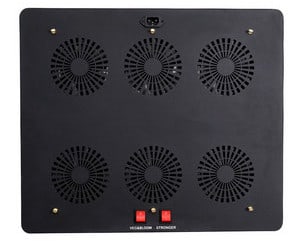 The CREE COBs are the stand-out feature.
The CREE COBs are the stand-out feature.
These high quality chip-on-board LEDs give you an intense light that penetrates far more deeply below the canopy than regular LEDs.
They also have a great full-spectrum white grow light, with half emitting warm white and half cool white light.
The supplementary diodes add red, blue, UV and IR to that white spectrum, making it even more ideal for plants. It works great for any stage of growth.
All 3 Phlizon fixtures are highly efficient.
They produce huge outputs over large coverage areas, while keeping power usage down (for exact numbers, check out the comparison table in the review).
They also have two separate (but confusingly named) power switches, so you can dial back the power and save some money when you don’t need full strength.
Pros
- Perfect spectrum for plants
- Powerful, bright output
- Low power usage
- Two separate power switches
- 50,000+ hour lifespan
- 2-year warranty and 30-day money back guarantee
Cons
- Slightly higher cost than other budget lights (mainly because they’re better)
- Labeling on the power switches is confusing
- No daisy chain feature
Best Budget COB: Aglex COB Series
- Ideal spectrum for plants — the perfect light for all stages of growth, with peaks on red and blue and healthy amounts of all other colors (which is what plants need)
- Deep canopy penetration — powerful COBs and 90 degree lenses penetrate deep into the canopy
- Bridgelux BXCD1734 COBs — high quality 3500K and 7000K COB LEDs provide a mix of warm and cool full spectrum white light
- Supplemental Diodes — 10w diodes add the perfect amount of red, blue, UV, IR and white light to the cool white COB spectrum
- Dual switches — saves money, since you can turn off some of the diodes when you don't need full power
- Rated for 50,000 hours — 4-5 years with no bulb changes
The Phlizon lights are my top choice, because they give you everything the industry standard Optic and Amare plant lights do, but at half the price.
Nevertheless, they are still priced a bit higher than other budget lights, so I decided to include my second favorite series that combines COBs with supplemental LEDs.
The Aglex COB series keeps costs down even more by using Bridgelux BXCD1734 COBs. These are high quality 5500K LEDs and provide a cool white light. That said, they are not CREE chips, which cost more and are the industry standard.
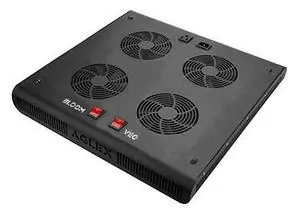 Apart from the less expensiveness components, there aren’t too many differences between Aglex and Phlizon. One big one is that the Aglex series has four grow lights, while the Phlizon series only has three.
Apart from the less expensiveness components, there aren’t too many differences between Aglex and Phlizon. One big one is that the Aglex series has four grow lights, while the Phlizon series only has three.
Note that Chinese brand naming conventions are in full force here, meaning 2000w is nowhere near 2000w. My reviews of these plant lights tell you the actual wattage of each one.
Since the Aglex lights use 5500K COBs, their spectrum is a bit different from the Phlizon, which uses a mixture of 3000K and 6000K.
The difference is not huge, but the Aglex has a bit more blue light and slightly less red.
Apart from that, Aglex does a better job of labeling their dual power switches (veg switch and bloom switch) and their lights can be daisy chained, so you can connect multiple lights and run them from a single outlet. These are great lights for any indoor garden.
Here is a summary of the main advantages and disadvantages for growers.
Pros
- Great indoor grow light for all stages
- Low price
- Separate veg and bloom switches
- Daisy chain feature
- 3 year warranty
Cons
- Bridgelux COBs instead of CREE (they are also good, but Cree is industry best)
- No money back guarantee
Best “Blurple” Full Spectrum LED: BestVA DC Series
- Highly efficient — about 50% less power consumption than the equivalent HID lights
- Full spectrum light — great for all stages of plant growth from vegetative stage to bloom
- Excellent core coverage — same as a the equivalent HID fixtures
- Double-chip Samsung LM301B diodes — deeper canopy penetration than standard chips
- Runs on AC85-265V — will work in any country
- Rated for 100,000 hours — 4-5 years with no bulb changes
- 3-year warranty and 90 day return guarantee— risk-free purchase
- Includes light and hanging kit — everything you need to start growing plants immediately
COBs give you a deeper canopy penetration than regular LEDs, but not everyone is a fan. And the truth is, the best non-COB LED fixtures are almost as good for indoor gardening.
My favorite series is the DC Series of lights from BestVA. DC stands for “double chip” and refers to the chip arrangement in the old fixtures. It’s not important, because they no longer have these double chips, but the company still uses the name at times.
For completeness sake, the old DC series used two 5 watt chips in conjunction to form a single 10w diode, which is actually similar to COB technology, except on a much smaller scale.
These 10 watt chips end up giving you a deeper canopy penetration than 3 watt or 5 watt chips, which is their main advantage. Of course, they actually consume far less than 10w.
The biggest disadvantage of the larger chips is heat, so you need to make sure the fixture can adequately deal with the additional heat output. The BestVA lights do a great job at keeping heat down, so that is not an issue here. And again, the double chips are no more, replaced by the much more efficient Samsung 301B.
All of the fixtures in the BestVA series (1000w, 2000w, 3000w, and 4000w) give you a large output and don’t consume much power. This makes for a more efficient indoor garden setup.
They use warm white and cool white diodes, in addition to diodes in red or blue. The results are full spectrum lights that work great for any stage of growth.
The color spectrum is similar to the spectra of the other lights on this list, but has more blue. This makes them especially effective for vegging, but they work great during all stages, thanks to a heavy dose of red light.
Here are the main pros and cons.
Pros
- Great indoor garden light for all stages of growth
- Low price
- 3 year warranty and 90 day money back guarantee
Cons
- Coverage area is smaller
- Coverage is not as even as bar and board style lights
- No daisy chain feature
Full Spectrum LED Grow Lights: Final Thoughts
As little as five years ago, LED grow lights were still inferior to HID in many ways. Most professional growers preferred to use HPS lighting. More modern outfits were switching to CMH.
But these days, LED grow lights have far surpassed other types. And they prices have come down. Way down. You can now get incredible LED fixtures for only a bit more than good HID systems. And the cost savings to operate the lights make up for that difference in no time.
There are basically four main options on the market now: blurple lights, COB lights, quantum board lights, and bar lights. The latter three all use full spectrum white light. Among them, bar style lights are currently the most popular, with quantum boards just behind them.
However, all 4 types work great to grow and flower plants, including marijuana. Whichever one you go with depends on your preferences and where you fall on the white light vs blurple light debate.
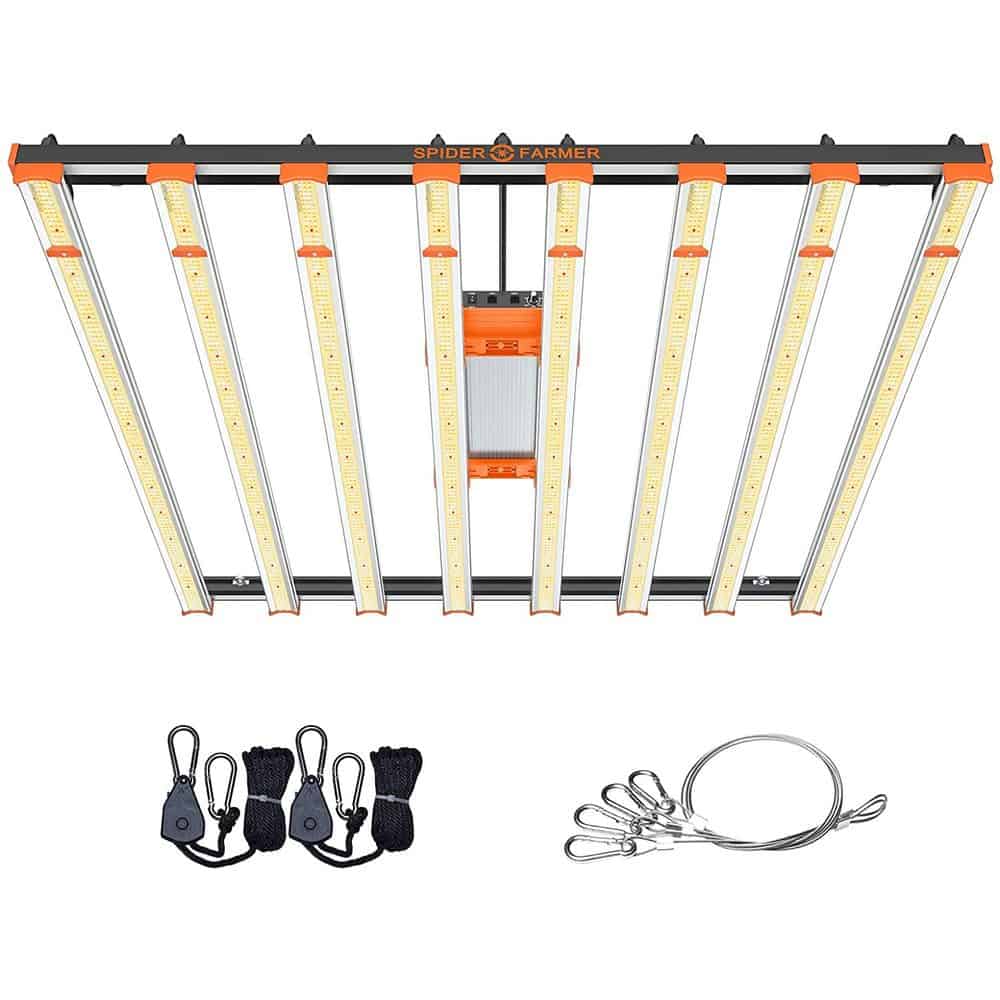
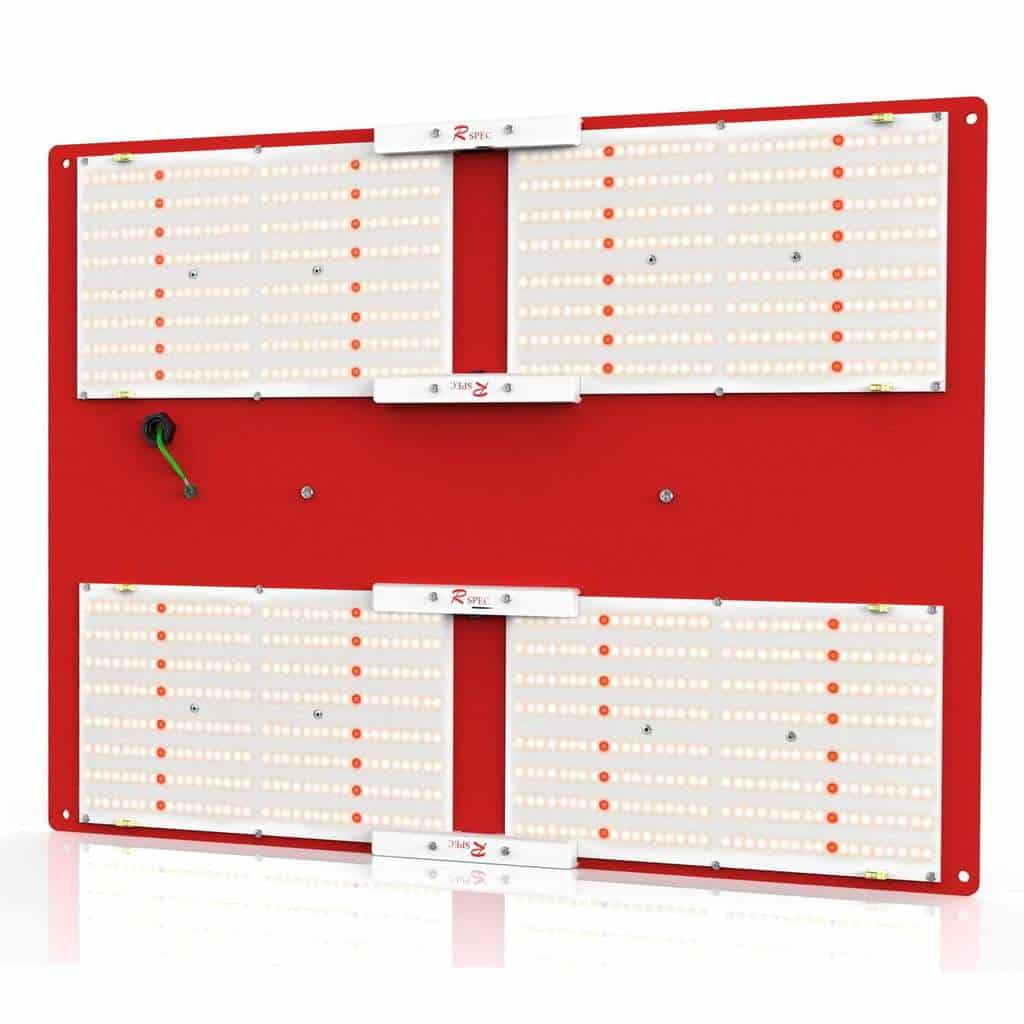
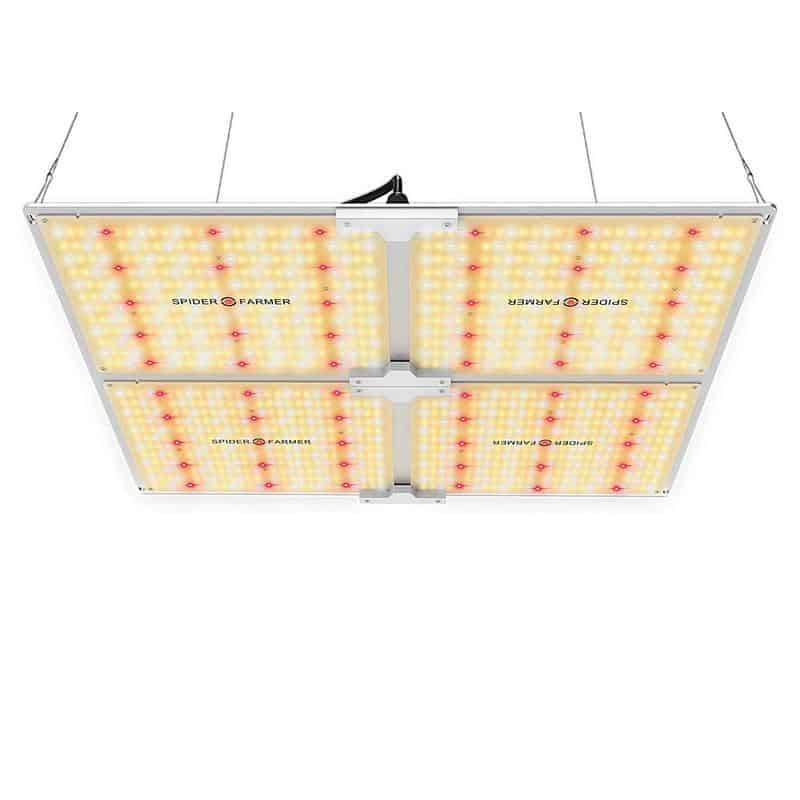

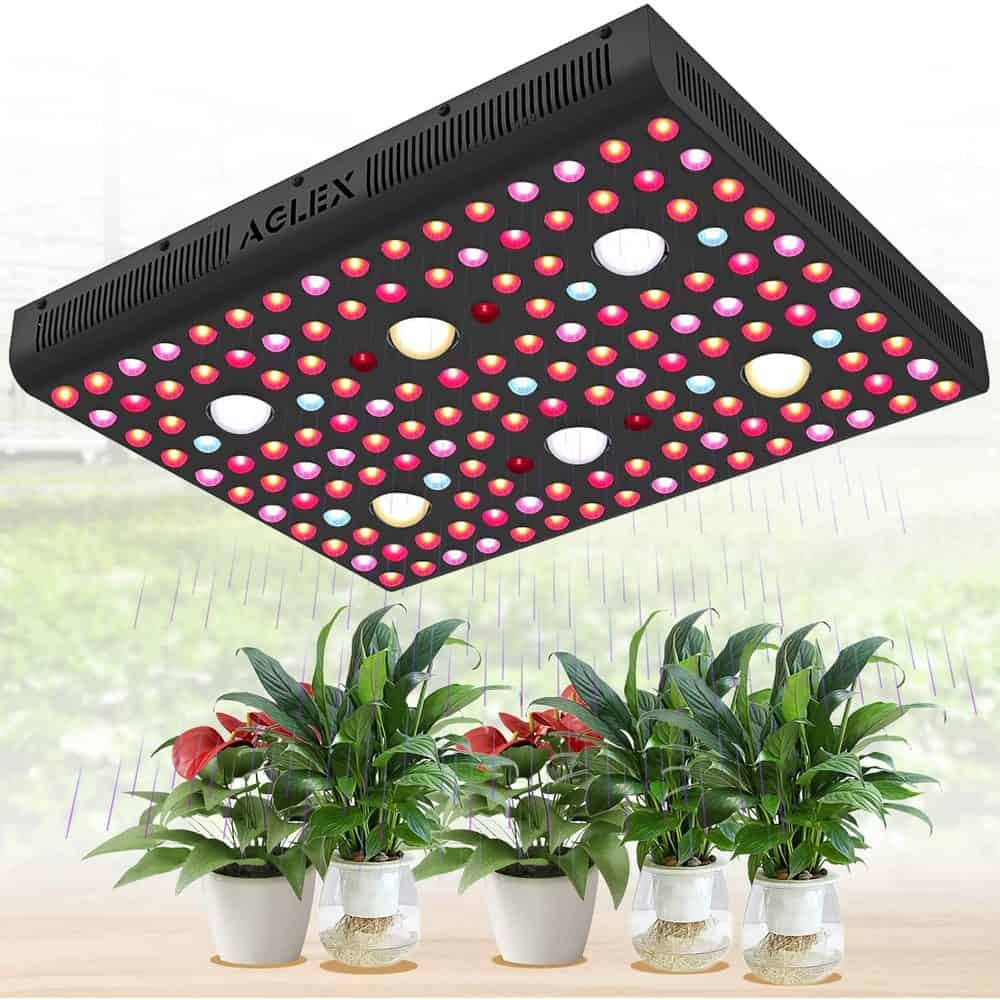
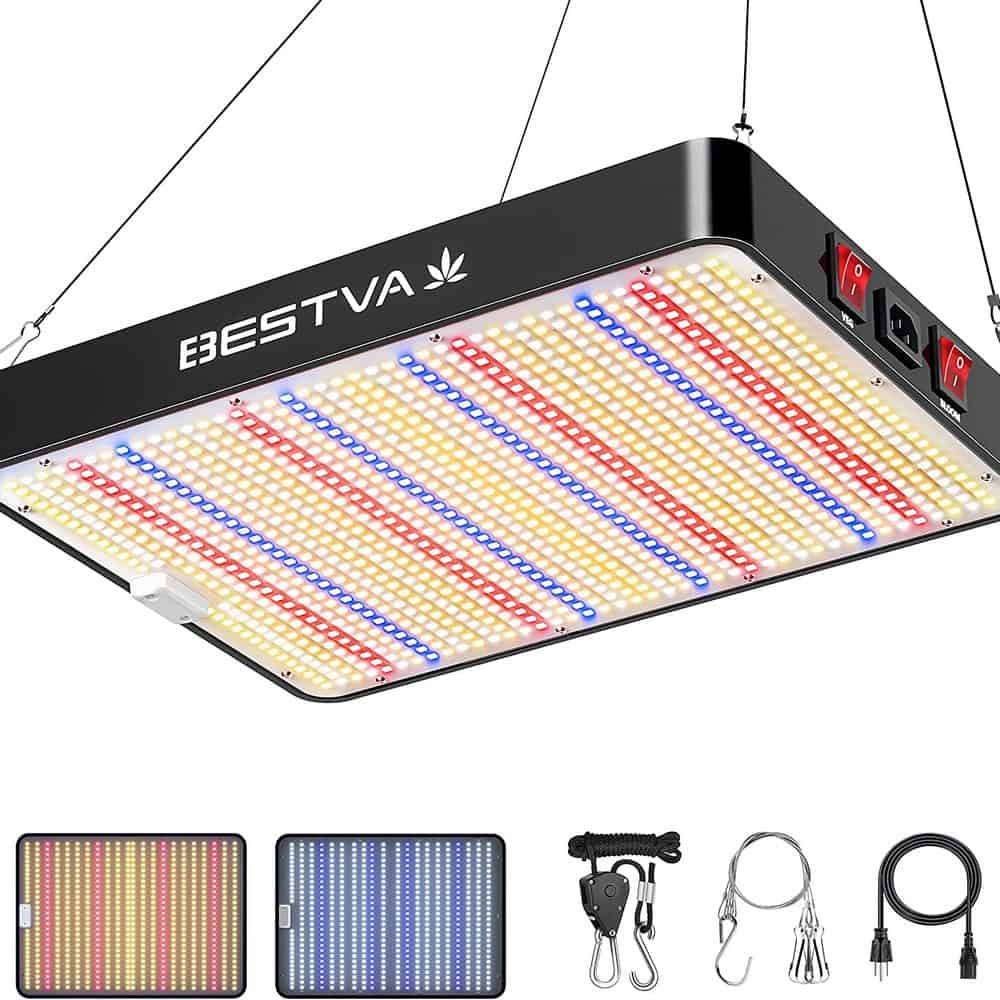





Enrique Gámez Menéndez says
Hello, I’m thinking in invest in some grow lights and get better light for my plants, and I was thinking because of the buget, to make my own grow light using 4 cree cob crx3590 to get a 400 w for a 4’x2’x4′ grow Room, but I find in my search with the Phlizon 2000 an looking in to it with this page, i don’t know all looks great with this light but I don’t find in any please the information about the 4 big cobs they are using, you mentioned that they use cree cob leds, but thats in the red, blue, uv little ones right? Can you tell my what cob are the 4 big ones? They are crx 3590 or another Chinese brand?, what do you think shuld I go for the dyt project or go for the phlizon? Note: i have some good grow leds now but they are not enough they have good red/blue output and I was thinking in plus they to the new cree dyt project!
Steven says
Cree is a brand, not a descriptor. They are Cree CXB3070 COBs. I can’t really tell you which way to go. If you want to do the work, DIY. If you want to just plug in the light and go, get the Phlizon. It just depends how much you value your time, I guess.
Figure out how much money you would save and how much time it would take and see what the savings per hour are. If it saves $50 and takes 5 hours, that would be $10 per hour. Is your time worth more or less than the number you come up with?
Jeff says
I’m primarily interested in growing lettuce, herbs, tropical houseplants, etc., but might occasionally want to try to grow tomatoes, peppers, etc. I’m also looking for good, and within reason, even coverage. I’m leaning towards the Phlizon COB or the Bestva DC (1000 or 2000?). I would appreciate your thoughts on these, or if you want to steer me in the direction of other lights (no burples, please) Thanks!
Steven says
The Phlizon lights are better.
Jeff says
Will the Phlizon cob be too powerful for lettuce? How high would the light need to be hung?
PS when recommended light heights are provided (for example 18”) does it mean 18” from the floor or 18” above the top of the plant? Thanks!
Steven says
It means 18 inches from the top of the plants. For lettuce, you’d probably want to hang it around the highest end of the recommended range.
Minh says
So i’m building a restaurant around a tree, the silver buttonwood. It’s going to be planted under a skylight, but i feel like i should probably have lights to supplement what it can get from the skylight. The skylight is probably 59″ x 90″. My roommate works for a company that does living walls and he told me they use sunstrips to keep their walls alive. I cant figure out what wavelengths are given off with these sunstrips and i don’t want the tree to die. From my 20 minutes of reading around so far ( I know i need a lot more), im thinking a full spectrum white COB is what i want. I’m hoping to find four spotlights that i can mount around the tree from the ceiling.
Any recommendations on lights, distance these should be placed from tree, etc? An input would be greatly appreciated!
Steven says
I’d look at the Rapid Single COB light. It is basically the same light as the Optic 1, but a bit cheaper.
As for height, I’d say 2-4 feet. It’s impossible to say exactly. You’ll just have to start them at 3 feet or so and adjust from there.
Minh says
Steven, thank you!
Do you think I should have four, one in each corner of a square above the tree, or would one positioned in the skylight pointing down st the tree be enough?
(I bought four, just wondering if I’m overdoing it. It’s expensive. But if this tree is the namesake for the restaurant, I want to do everything I can to ensure its survival)
Steven says
If you already have 4, I’d use 4. My guess is one isn’t enough, but you can always try it with one and see how it goes. That’s really the only way to know for sure.
Sander says
Hi there,
you did not include the Spider Farmer SF-1000 in this review. When comparing the two reviews it seems you have a preference; but could you explain which one you would choose today?
So how does the Spider Farmer compare to the ones mentioned in this review?
Thank you in advance!
Steven says
You’re right, this article needs to be updated to include the Spider Farmer lights. I probably prefer the Phlizon slightly over the Spider Farmer, but they’re both pretty much equal. It just comes down to whether you prefer the tiny diodes of the SF or the COBs on the Phlizon.
Philip Cox says
pseudo-technical gobbledygook ….
chlorophyll-a wants 420 nm (blue) and 660 nm (red) a cool-white or full spectrum led gives this.
chlor0phyll-b: the peak wavelengths a shifted (435 & 643))
carotenoids and phycobilins use other colors (green/yellow/amber) but their contributions to most plants metabolism are minuscule compared to the chlorophylls
Rafael Ferreira says
I would like to know how much lighting for an area of 125 x 125 pés, for maximum efficiency.
Russel Black says
Well, the only light source with a literal full spectrum is the sun. Of course having plants outside where the sun can reach them means that were dependent on other factores such as weather, humidity, yada yada. But when you have a HIGH spectrum covering light, the job becomes much easier as you can control most of the variables. I like running the iL8x because it covers the majority of the spectrum for the growth cycle of my plants, and its dimmable for my liking. Definitely one of the best lights out there and makes it easy to control the results you want.
savannah says
Hi, your review only for people wish to grow a gardant in the house. My plants are scattered throughout the house. I am looking for something like a floor lamp so it can be moved around the house. Any good suggestions?
Alexandra says
Hi, Bestva launch a new series, called BAT series. I have a BAT w600 grow light which have full specturm and wifi control. It really works well.
https://www.bestvaled.com/collections/bat-series-led-grow-lights/products/bestva-bat-w600-dimmable-led-grow-light-for-your-indoor-grow-1680pcs-samsung-lm301-diodes-5-5ft-coverage-by-wifi-control
SHARON BARNES says
I am 150% confused. Have spent HOURS trying to find the right grow lights for various sizes of succulents that I moved indoors for the winter. Want something easy to install, not ugly/commercial-looking. Bought bulbs, but they don’t spread light very far. Amazon had free-standing lights, but there are so many I have no idea of which to select. Can you recommend something for my home that either hangs from a wall bracket or is free-standing? Can’t afford to spend $1000. Thanks!